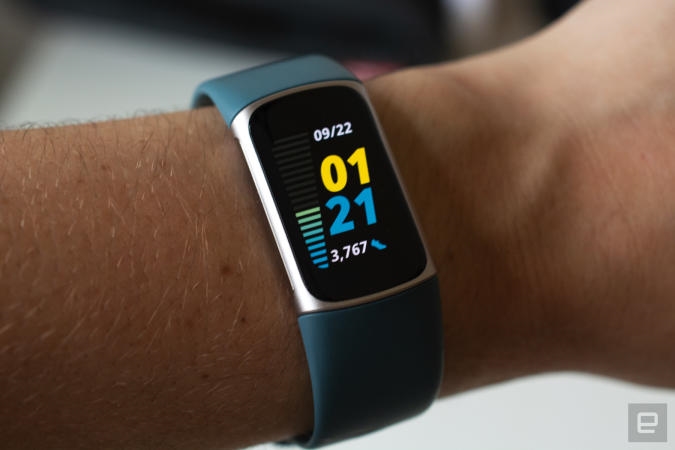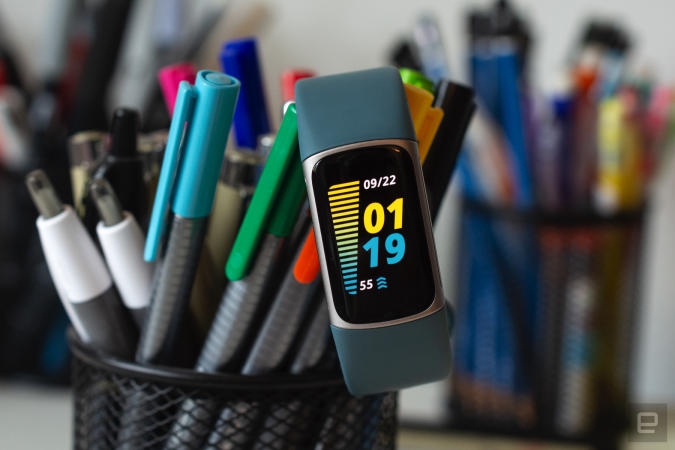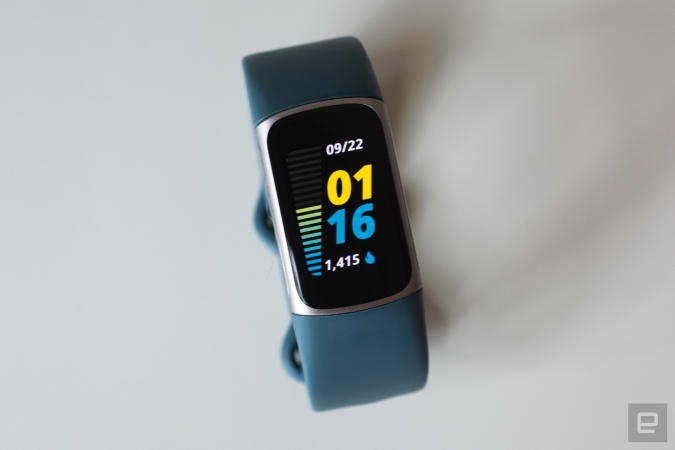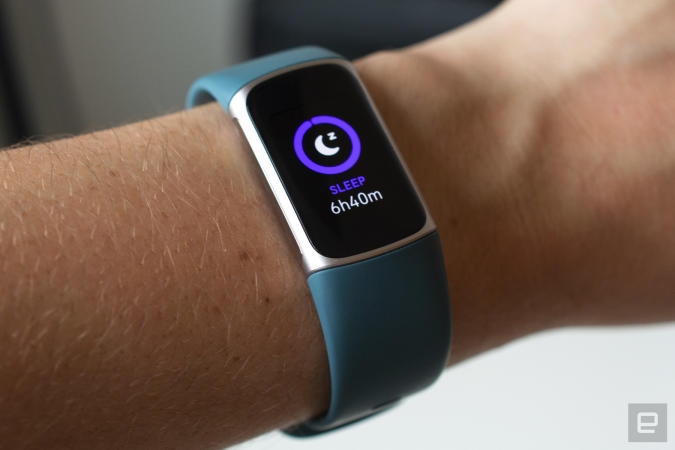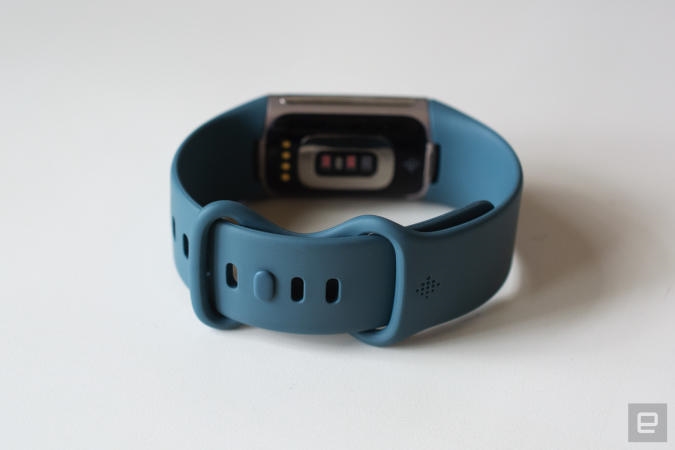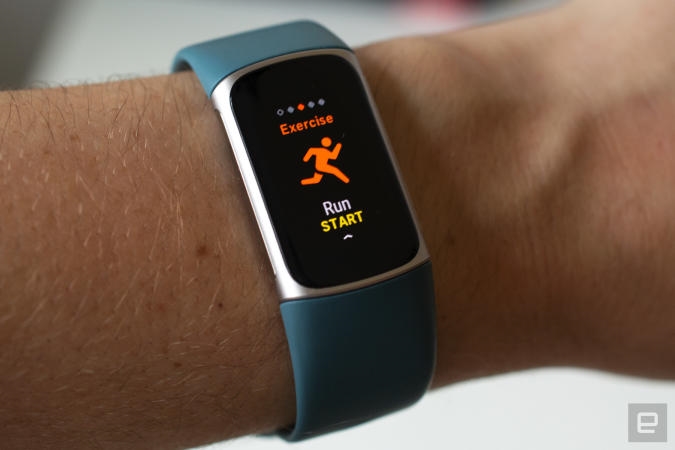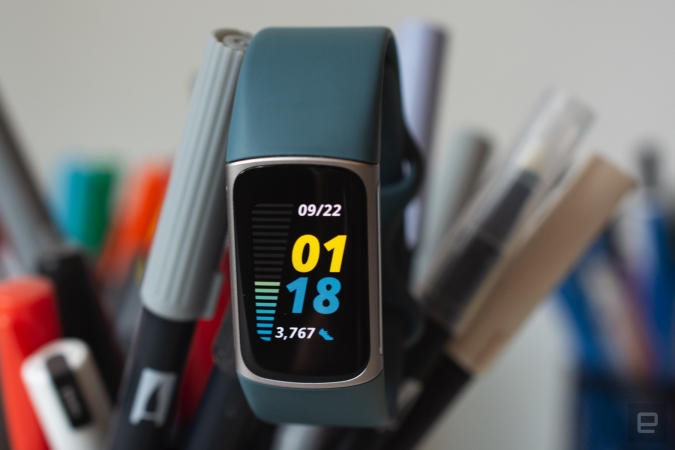Fitbit’s Charge 5 tracker is back on sale for a record-low $130 at Amazon
Fitbit Charge 5 review: New look, same tricks
The $180 band has a slick new design, but GPS is still the biggest selling point.

Fitbit went back to basics with last year’s Charge 4, reinstating a fitness tracker with onboard GPS into its lineup after many years of leaving that hole unfilled. With the introduction of the $180 Charge 5 this year, the company is trying to modernize its most capable band. It’s thinner, lighter and less bulky than the Charge 4 and it now has some features previously reserved for Fitbit’s full-fledged smartwatches, the Versa and Sense.
That translates to a $30 increase in price, and on top of that, Fitbit’s hoping you’ll pay $10 each month to access your historical health data (and more) through Fitbit Premium. The Charge 5 certainly feels more polished than the Charge 4, but those who prefer bands to smartwatches will find that most core features remain the same — and you’ll have to decide if the perks of Premium are really worth paying for.
Charge 5
Pros
- Full-color touchscreen with optional always-on mode
- More comfortable design
- On-device EDA sensors for stress monitoring
- Built-in GPS
- Fitbit Pay
- Multi-day battery life
Cons
- $30 more than the Charge 4
- Can’t control music playback from the screen
- Limited on-device apps
- Not compatible with Apple Health or Google Fit
Design
I was surprised by how much of a difference was made by Fitbit updating the design of the Charge 5. It’s 10 percent thinner than the previous version and has new rounded edges, and the module itself is stainless steel in a color that should complement the band choice you picked. It feels less bulky on the wrist and its rounded edges make it so the device doesn’t stick out as much. If you’re wearing the band tightly, the Charge 5 sits more flush against the wrist than the Charge 4 did, so it’s less obtrusive and more comfortable. The strap is also better, too: the Charge 5 comes with a soft-touch band that looks (and hooks) almost like the Apple Watch’s sport bands.
Gallery: Fitbit Charge 5 review photos
The display has been updated as well: it’s a 1.04-inch color AMOLED touchscreen that wakes up when you lift your wrist. It’s leaps and bounds better than the grayscale OLED screen on the Charge 4 and it puts the Charge 5 more in line with Fitbit’s smartwatches.
It also has a new always-on feature, which you can activate in the settings. It will automatically turn off at night if you have sleep mode turned on, but otherwise, it keeps the clock and watch face on, if slightly dimmed, all day long. This obviously affects battery life and Fitbit makes that clear.
But with the addition of a touchscreen, Fitbit took all physical buttons off of the Charge 5. You may think the shiny slivers on the long edges of the module are capacitive-touch buttons but they’re not — they’re actually the electrodermal activity (EDA) sensors that enable stress monitoring. While I didn’t have any problems using the touchscreen, it was a bit weird to not have a button to fall back on because I was used to the inductive side button on the Charge 4.
New (and old) features
Fitbit trickled down a few advanced features from its Sense smartwatch to the Charge 5, namely ECG measurements and EDA monitoring. The former is “coming soon,” so I wasn’t able to test it, but the latter is similar to the EDA tool on Fitbit’s smartwatch. Instead of covering the device’s screen with your palm like you would on the Sense, the Charge 5 has two long sensors on its sides that you pinch and hold when you want to take an EDA scan.
At first, I didn’t know you could change the duration of each scan, so I sat in semi-frustrated silence for three whole minutes (torture, I know). The EDA sensor looks for changes in your skin that may be linked to stress and it’ll report how many differences it captured at the end of the scan. The Charge 5 reported 18 incidents in my first session, which probably reflected my increasing frustration with the tool as I used it.
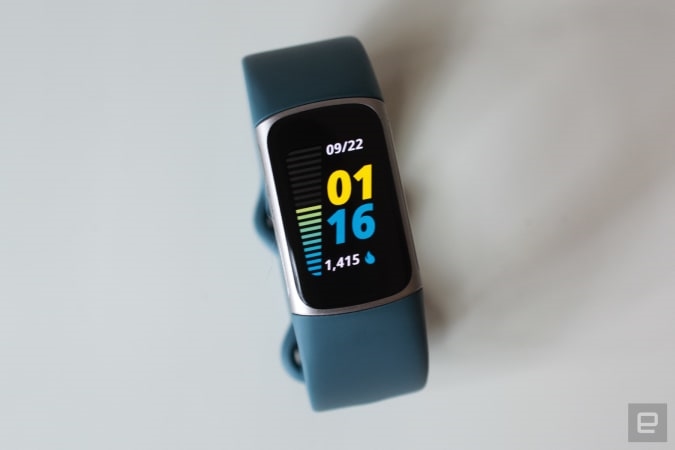
The device’s screen counts down the remaining time in your scan, but it doesn’t show anything else. Fitbit used to have guided breathing exercises on its devices which would take you through a few minutes of breathwork with the intention of calming you down. Fitbit still has meditation exercises available in its app (most available via Premium, with only a scant few free) but I wish Fitbit had brought over that aspect into its EDA tool on the Charge 5. I never felt significantly more calm after a scan — if anything, pausing during my busy day to have my fitness tracker tell me that I might be stressed, without providing any aid, made me more annoyed than less.
Otherwise, the Charge 5 is much the same as the Charge 4, although all of its features look a bit more glossy thanks to the full-color screen. The GPS was, arguably, the most important thing about the Charge 4 and it remains solid on the Charge 5. The built-in sensor grabbed my location within seconds of me starting a run and my route was accurately mapped in Fitbit app after I synced.
But Fitbit didn’t add more music-focused features. In fact, it actually removed some, which is a bummer. The Charge 4 had no onboard storage and only Spotify Premium subscribers could control playback from its screen. According to Fitbit, it’s data showed that customers weren’t using the music controls a lot, so they removed the Spotify option as well. While I understand the logic, I was disappointed each time I ran with the Charge 5 — I would turn to my wrist to skip a track only to immediately realize I had to take my phone out of my fanny pack.
On a positive note, Fitbit added solid alarm and timer apps on the Charge 5. The device is not designed to have as many onboard programs as a smartwatch, but these are pretty basic and many fitness bands include them. I love being able to set daily alarms so I never forget to take medication, and I inevitably end up setting a timer or two each day to keep track of laundry, cooking food and the like.
What you get with Premium
Fitbit has been slowly incorporating Premium, its $10-per-month health and fitness service, into all of its devices over the past few years. What that means for the Charge 5 is that some advanced metrics are behind that paywall, along with things like wellness reports, guided workouts, meditations, recipe inspiration and more.
My biggest problem lies with the walled-off health metrics. It essentially means that Fitbit users can only get the data necessary to up their sleep and exercise game if they pay for it. You may only realize how much of your data you don’t have access to after using the Charge 5 for months, too, which is a bummer (you get six months of Fitbit Premium when you buy a new Charge 5, so at least you’ll get a taste of it).
For example, Premium gives you access to 30-day and 90-day health trends based on your recorded data, plus “advanced” health insights related to your heart, activity, sleep and more. And Fitbit’s wellness reports, which gathers your recorded information about heart rate, steps, weight, water and food intake, exercise, sleep and more for you to easily give to your doctor, are only available to subscribers.
A new feature only available to Premium subscribers is what Fitbit calls a Daily Readiness Score. It basically tells you how ready your body is to work out any given day based on things like heart rate variability, sleep and fitness fatigue. This sounds similar to Garmin’s Body Battery score (which, by the way, doesn’t cost anything extra).
However, I couldn’t test this out because it’s “coming soon” just like the ECG app I mentioned earlier. Fitbit has hyped up its new products with coming-soon features for years, with at least a few of them taking forever to actually arrive. It should go without saying, but I wouldn’t recommend buying a Fitbit device for any yet-to-be-released features — it may take months for them to actually arrive.
This isn’t a Fitbit Premium review — I haven’t gathered enough data with the Charge 5 to get the most out of the service, and that can only be done by spending at least a few weeks to a few months with it. But I will say that Premium really isn’t for someone like me who already has a fitness system in place and already tries to eat as healthily as possible (most of the time). But it may be useful for those just getting started on their fitness journey, whether that means they’re trying to lose weight, exercise more regularly or eat better. Premium’s video workouts and recipe inspirations aren’t particularly special (I guarantee you’ve seen similar one-minute recipe videos on Instagram), but having them all in one place encourages you to use them on a daily basis. A common idea in the fitness world is that the hardest part of working out is actually showing up to do it. That can translate to many parts of someone’s health journey — Fitbit’s Premium service removes a lot of the guesswork that can make living healthier seem inconvenient.
Battery life
Fitbit promises up to seven days of life on the Charge 5, but that estimate drops to two days when you have the screen in always-on mode. Thankfully, Fitbit’s estimates were mostly correct — I got about two and half days with always-on mode enabled and five with it disabled. Just keep in mind that how often you use the built-in GPS will affect battery life, too. During my time with the device, I used the GPS almost every other day for 45 minutes to one hour during my runs.
The competition
It’s hard to compare the Fitbit Charge 5 to other fitness trackers because there aren’t many at the $180 price point. Most simple band-style trackers are more affordable, like the $80 Garmin Vivofit 4 or the $130 Vivosmart 4, while smartwatches like the $200 Garmin Forerunner 55 dominate the higher end. Arguably the most comparable device out of those is the Vivosmart 4, which has a thinner design but a less exciting, grayscale OLED screen. It also only has connected GPS, not onboard, but it does have features like all-day activity monitoring, workout tracking, VO2 max measurements, Body Battery scores, sleep and blood oxygen tracking and more. It also does have music controls directly on the device and a similarly long battery life.
And when it comes to Fitbit’s own lineup, the Charge 5 shares a lot of features with the $150 Luxe. Sure, the latter is thinner and targeted more towards those who want a bracelet-like wearable, but it’s more affordable and has a full-color display (which will soon support always-on mode), activity and sleep tracking, smartphone alerts, and more. What it doesn’t have is onboard GPS and Fitbit Pay.
Wrap-up
When you’re talking about $180 for the Charge 5, it’s tempting to say “just get a smartwatch instead.” You could get a capable Garmin smartwatch for only $20 more than that, or even an Apple Watch Series 3 (although I wouldn’t recommend the latter). But one of the reasons many will consider the Charge 5 is its band style — some people just prefer that to larger smartwatches. In general, fitness bands have lower profiles, multi-day battery life and they typically keep fitness at the forefront. If that sounds like what you’re looking for in a wearable, the Charge 5 is a breath of fresh air.
But considering its biggest perks are onboard GPS and Fitbit Pay support with NFC, the Charge 5 remains pretty similar to the Charge 4. It’s also disappointing that Fitbit didn’t really fix much about the previous band other than its dated design. You still have a limited selection of apps on the Charge 5, it doesn’t integrate with Apple Health or Google Fit and Fitbit removed all music control functionality, even for Spotify Premium users. I’d expect more progress and differentiation in a device that now costs $30 more. You could safely skip this update if your Charge 4 is still serving you well. But if you don’t have a fitness tracker right now, the Charge 5 remains one of your best options if you’re looking for a capable band with built-in GPS.
(20)

